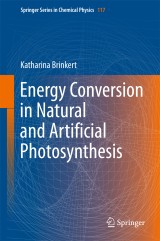Details

Energy Conversion in Natural and Artificial Photosynthesis
Springer Series in Chemical Physics, Band 117
|
CHF 165.50 |
|
| Verlag: | Springer |
| Format: | |
| Veröffentl.: | 16.03.2018 |
| ISBN/EAN: | 9783319779805 |
| Sprache: | englisch |
Dieses eBook enthält ein Wasserzeichen.
Beschreibungen
<p>This book discusses the basic principles and processes of solar energy conversion in natural photosynthesis. It then directly compares them with recent developments and concepts currently being pursued in artificial photosynthetic systems that are capable of utilizing sunlight to convert carbon dioxide and water into a chemical fuel. </p><p>In this regard, the main focus is on photoelectrochemical cells, in which semiconducting photoanodes and -cathodes modified with (electro-) catalysts are used to oxidize water, produce hydrogen and reduce carbon dioxide in a monolithic device. The fundamental photochemical and photophysical processes involved are presented and discussed, along with protection mechanisms and efficiency calculations for both natural and artificial photosynthesis. In turn, key parameters that are crucial for the efficient operation of natural photosynthesis are identified. Lastly, their validity and applicability in the design of artificial solar-driven water-splitting systems are examined. <br></p><div><br></div>
<p>Introduction: Comparing Solar Energy Conversion Processes in Natural and Artificial Photosynthesis.- Photosynthesis - A Brief Overview.- Biomimetic Systems for Artificial Photosynthesis.- Architecture, Structure and Composition of the Energy Conversion Centres.- Light Absorption and Excitation Transfer.- Electron Transfer.- Water Oxidation Catalysis and Hydrogen Evolution.- Carbon Fixation.- Protection Mechanisms.- Photosynthetic Efficiency.- Summary: Towards the Realization of an ‘Artificial Leaf’.</p>
<p><b>Katharina Brinkert </b>received her Ph.D. degree from Imperial College London and a M.Sc. from Uppsala University, Sweden. Currently, she is holding a Leopoldina PostDoctoral Scholarship for her work with Prof. Harry B. Gray at the California Institute of Technology. She has specialized in natural photosynthesis and molecular bioenergetics and is presently advancing artificial photosynthesis systems, analyzing and developing photoelectrochemical solar fuel cells. Previously, she was a Research Fellow at the European Space Agency, where she investigated light-assisted hydrogen production in semiconductor-electrocatalyst systems in micro-to-zero-gravity environments for life sustaining applications in space. Her research interests comprise fundamental processes of light-assisted water oxidation, CO<sub>2</sub> reduction and N<sub>2</sub> fixation, solar energy conversion systems and investigations of hybrid enzyme-semiconductor structures for sensoric and (photo)electrocatalytic applications. Dr. Katharina Brinkert is a member of the International Society of Photosynthesis Research, International Society of Electrochemistry (ISE), The Electrochemical Society (ECS), Gesellschaft Deutscher Chemiker (GDCh), German Bunsen Society for Physical Chemistry (DBG), Solar Fuels Network (UK) and she is a member of the Royal Society of Chemistry (RSC).</p>
<p>This book discusses the basic principles and processes of solar energy conversion in natural photosynthesis. It then directly compares them with recent developments and concepts currently being pursued in artificial photosynthetic systems that are capable of utilizing sunlight to convert carbon dioxide and water into a chemical fuel. </p><p>In this regard, the main focus is on photoelectrochemical cells, in which semiconducting photoanodes and -cathodes modified with (electro-) catalysts are used to oxidize water, produce hydrogen and reduce carbon dioxide in a monolithic device. The fundamental photochemical and photophysical processes involved are presented and discussed, along with protection mechanisms and efficiency calculations for both natural and artificial photosynthesis. In turn, key parameters that are crucial for the efficient operation of natural photosynthesis are identified. Lastly, their validity and applicability in the design of artificial solar-driven water-splitting systems are examined. <br></p><div><br></div>
Provides a direct comparison and overview of solar energy conversion processes in natural photosynthesis and artificial, biomimetic analogs Includes essential information for the design of solar water-splitting cells/solar fuel-producing devices Presents the content in a highly accessible way, using simple language, illustrations and tables

















